The little church of the Borgo
The origins of the present parish complex of the Annunciation of the Virgin Mary in the Borgo date back to the mid-eighteenth century, when, on the site where the church stands 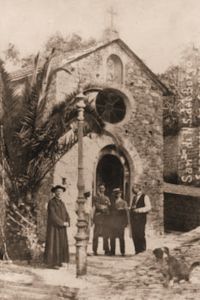 today, a modest chapel with an adjoining rectory was erected, surmounted by a small bell tower. The decision to build the small church at the end of the 19th century was taken by some believers in the area to honour in a more suitable and appropriate way the effigy of the Madonna, painted on a slate slab of a stucco decorated portal belonging to the Borea brothers, situated in the lower Tinasso area, where the Virgin appeared with her hands joined halfway down her bust and her head slightly reclined on one shoulder, surrounded by some cherubs hovering in the sky in an act of adoration.
today, a modest chapel with an adjoining rectory was erected, surmounted by a small bell tower. The decision to build the small church at the end of the 19th century was taken by some believers in the area to honour in a more suitable and appropriate way the effigy of the Madonna, painted on a slate slab of a stucco decorated portal belonging to the Borea brothers, situated in the lower Tinasso area, where the Virgin appeared with her hands joined halfway down her bust and her head slightly reclined on one shoulder, surrounded by some cherubs hovering in the sky in an act of adoration.
The small church soon became the destination of continuous pilgrimages and its walls were filled in a short time with numerous ex votos as a testimony of the many graces received by the faithful. So it was that, in order to further spread the cult of the Virgin of the Borgo, fifteen tabernacles were built along the route that led from St. Joseph's door to the churchyard, next to the walls, on which the mysteries of the Rosary were painted.
Since the limited internal capacity of the church was no longer sufficient to contain the ever-increasing number of faithful who wished to participate in the sacred services, Senator Ernesto Marsaglia entrusted the engineer Pietro Agosti with the task of studying a considerable extension together with the architect Gussoni of Turin. At the same time, subscriptions were opened and charity auctions were organised in order to raise the funds needed to enlarge the church, to which Queen Margherita also contributed, sending a pair of blue porcelain vases from Sèvres. 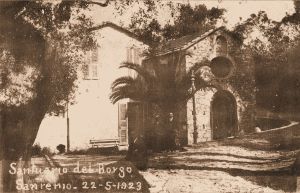 The project prepared by Agosti and presented in 1908, also provided for the construction of a large communication artery that was to connect the sea coast in a straight line, through the current Corso Mombello, Via Feraldi and Via Martiri della Libertà, with the square of the sanctuary of the Madonna del Borgo. During the following works the body of the building, slightly advanced on the square, was harmonized with the pre-existing structure with the vaults and pilasters adorned with capitals that supported the crowning frame.
The project prepared by Agosti and presented in 1908, also provided for the construction of a large communication artery that was to connect the sea coast in a straight line, through the current Corso Mombello, Via Feraldi and Via Martiri della Libertà, with the square of the sanctuary of the Madonna del Borgo. During the following works the body of the building, slightly advanced on the square, was harmonized with the pre-existing structure with the vaults and pilasters adorned with capitals that supported the crowning frame.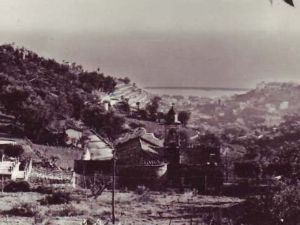 Due to lack of funds, the exterior was left with the previous covering of visible stones, while above the central rose window, under the junction of the pitched roof, a bas-relief depicting the Madonna was placed, made in 1900 by the Piedmontese sculptor and decorator, but Sanremo by adoption, Giovanni Bagliani.
Due to lack of funds, the exterior was left with the previous covering of visible stones, while above the central rose window, under the junction of the pitched roof, a bas-relief depicting the Madonna was placed, made in 1900 by the Piedmontese sculptor and decorator, but Sanremo by adoption, Giovanni Bagliani.
When the work was interrupted due to the First World War, the chaplain of the sanctuary, Don Costanzo Scarella, who died in February 1918, was replaced by Don Ferruccio Piggioli, who commissioned the ladies Maria Bottini and Maria Modena to collect oblations from the faithful in order to finally carry out the 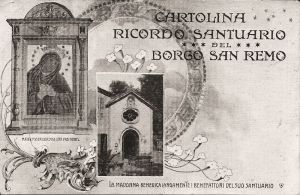 complete enlargement of the church, which would assume the attribute of "votive temple for Peace".
complete enlargement of the church, which would assume the attribute of "votive temple for Peace".
Set aside the Agosti project, the architects Carlo and Giovenale Gastaldi were asked, who prepared various projects, but then refused the assignment because of deep disagreements with Don Piggioli about their intention, not welcomed, to keep the old sanctuary in the same position where it had been erected in the mid-eighteenth century.
In the end it was decided to completely demolish the old chapel and in its place a small church dedicated to the Madonna del Borgo was erected in 1922. However, given the precariousness of its foundations, it threatened to collapse a few years after its construction. There was talk of renovations and also on this occasion the administrators of the church turned to a technician, the engineer Domenico Parodi, for the elaboration of a new project of consolidation and enlargement of the structure.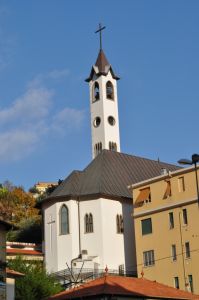 Then, considering the considerable increase in the number of the faithful in the neighbourhood, the Bishop of Ventimiglia Rousset decided to accept the requests of the population to be able to take advantage of the religious assistance of a priest, and, with a decree of 3 March 1959, erected the church of the Borgo as a parish church, entrusting its management to Don Vittorio Marteletti, who was its first parish priest from 1959 to 1986, who, unable to carry out his ministry in the old church which was now in danger, made the proposal to rebuild the new church near the road below.
Then, considering the considerable increase in the number of the faithful in the neighbourhood, the Bishop of Ventimiglia Rousset decided to accept the requests of the population to be able to take advantage of the religious assistance of a priest, and, with a decree of 3 March 1959, erected the church of the Borgo as a parish church, entrusting its management to Don Vittorio Marteletti, who was its first parish priest from 1959 to 1986, who, unable to carry out his ministry in the old church which was now in danger, made the proposal to rebuild the new church near the road below. 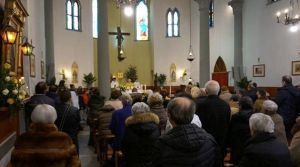 Once the old sacred building had been demolished, the surveyor Giorgio Maiano was given the task of designing and directing the work on the new church, which was built in neo-Gothic style in just one year and solemnly blessed on June 18, 1961.
Once the old sacred building had been demolished, the surveyor Giorgio Maiano was given the task of designing and directing the work on the new church, which was built in neo-Gothic style in just one year and solemnly blessed on June 18, 1961.
In the years immediately following, the complex was then completed with the construction of the bell tower, the sacristy and the parish works. Finally, inside the new church there is the presence, on the left side of the nave, of a painting depicting the Madonna, made by an unknown artist from western Liguria during the XVIII century.
(texts: Andrea Gandolfo; Ernesto Porri - Image sources: personal archive; WEB)




